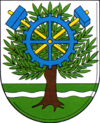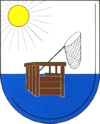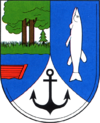Coat of arms of the Treptow-Köpenick district
The coat of arms of the Treptow-Köpenick district was created after the 2001 merging of the Treptow and Köpenick districts from the previous coats of arms of the two districts. Köpenick's coat of arms exerted a greater influence here, as it is the older - even the oldest coat of arms of all today's Berlin districts.
The new coat of arms was awarded on September 21, 2004 by the Berlin Senate .
Blazon
“In blue a green dew cross with pawed ends, provided with a golden bar border , accompanied by two inwardly turned upright silver fish. The rope cross is covered with a golden key with a beard turned to the left and 7 four-pointed stars (4: 2: 1). A red three-tower wall crown rests on the shield , the central tower of which is covered with the Berlin coat of arms . "
History and meaning
Koepenick
The Köpenick coat of arms probably appeared for the first time in the 13th century and can be traced on seals and stamps from the 14th century. It has a blue tinged shield in which there is a raised golden key with a beard pointing to the left. Seven four-pointed decorative stars are grouped around the key, one of which is hidden in the key handle. The keys and stars are flanked by two upright, facing silver carp.
The blue tinging of the sign symbolizes the abundance of water at the place where the Dahme flows into the Spree and the many bodies of water in the vicinity. The two fish symbolize fishing, which used to be a vital livelihood for the population. The seven stars are the Pleiades , also known as Pleiades. According to ancient tradition, they are considered to be the fishermen's guardian stars, perhaps because, as winter stars, they mark the season that is dangerous for shipping. A reference to the seven big stars of the constellation Orion would also be conceivable . Orion was the son of Neptune , was a hunter, but according to one story he died while fishing.
In later depictions the stars also have the shape of St. Andrew's crosses and in the 17th century they disappeared from the seals and coats of arms. There are several interpretations for the key. Two of these are most likely. One interpretation says that the key is to be regarded as the "city key" and that it was included in the coat of arms in the course of the city charter. The other interpretation sees the key as a symbol for the apostle Peter , who was also a fisherman (in Galilee ) and is considered the patron saint of fishermen. Further interpretations are that the key symbolizes power and trust. "Only those who received it as a heraldic figure, whose loyalty, discretion and willingness to serve had been proven." The coat of arms has remained relatively unchanged over the centuries and has only been adapted to modern forms of representation over time.
Treptow
The Treptow coat of arms comes from the time when the urban Gut Treptow became an administrative district in the Teltow district in 1874 and an independent rural community in 1876 . The coat of arms shows a group of trees on the left and one on the right in silver on green ground. Initially, the groups of trees consisted of three deciduous trees each, as can be seen from Treptow's oldest seal. Today the right group consists only of two deciduous trees. Both groups of trees are separated by a wavy band in the left part of the sign, which represents a river. In the center of the shield and on the right-hand side of the floor stands an upright red-tongued black bear.
The deciduous trees symbolize the forest wealth of the Treptow settlement area at that time. The river should remind of the location on the Spree and the Landwehr Canal. Originally it symbolized the Heidekampgraben , also called Kuhgraben, which cut through the former rural community of Treptow and flowed directly into the Spree next to the former Vorwerk . This is also the cradle of Treptow. On the seal (picture on the right) you can clearly see that the ditch flows into a river at the bottom left. The bear symbolizes not only - as a "place at the gates of Berlin" - the bond with Berlin, but also the real estate of the city of Berlin on the community corridor. Treptow's coat of arms has also remained largely unchanged since its creation and has only been adapted to more modern forms of representation over time.
District coat of arms
| District coat of arms from 1920 | |

|

|
| Treptow | Koepenick |
| District coat of arms from 1992 | |

|

|
| Treptow | Koepenick |
When the Treptow and Köpenick districts were formed in 1920 , the coats of arms of the eponymous districts were also adopted for the entire district.
Both coats of arms were revised for the 750th anniversary of Berlin in 1987. The stars symbolizing the seven stars were also included in the Köpenick coat of arms. After the reunification of Germany , the district coats of arms were revised again in September 1992 and they were given the crown connecting all the city districts with Berlin , just like the coats of arms of the districts in the western part of Berlin.
On January 1, 2001, the two districts of Treptow and Köpenick merged to form the new district of Treptow-Köpenick. Since the two historical districts each have their own significant historical and cultural past, one district could not simply be incorporated into the other. On the one hand, this found expression in the new double name of the Treptow-Köpenick district , on the other hand, a new coat of arms had to be found that does justice to both former districts. The new coat of arms is the result of a commissioned work including a heraldic evaluation. On September 21, 2004, the Treptow-Köpenick district was awarded the coat of arms by the Senate (designed by heraldist Frank Diemar ). For description (blazon) see above . The two fish from the Köpenick coat of arms still stand for fishing. But not only the first settlers of the Köpenick district lived from the fishing, but also other districts of the district. The districts of Müggelheim , Rahnsdorf and Schmöckwitz also have symbols of fishing in their coats of arms. And the first settlers in Treptow were fishermen. The key, the newly arranged seven stars in the tau cross and the blue tinging of the shield are taken from the Köpenick coat of arms. Nothing has changed in their meaning. The tau cross, which has the shape of the letter "T", stands for the name Treptow. The green tinging of the tau cross is taken from the Treptower coat of arms. Blue and green stand for the extensive river, lake and forest landscapes of the new district. The wall crown resting on the shield with the Berlin coat of arms symbolizes, as with the old district coats of arms, the bond with Berlin.
The districts
Not only the two eponymous districts of the Treptow-Köpenick district have their own coats of arms, but also the districts of Friedrichshagen, Johannisthal, Müggelheim, Oberschöneweide, Rahnsdorf and Schmöckwitz have long had their own coats of arms.
The coats of arms of the districts lost their validity with the incorporation into Greater Berlin and thus disappeared from official use.
Friedrichshagen
The oldest used Friedrichshagen seal from 1793 shows an oak wreath and is only indicated with the place name. The coat of arms on the right has been shown in the seal since 1808. This seal bears the inscription "FRIEDRICHSHAGENSCHES DORFSIEGEL".
The shield of the coat of arms is divided. Above, in gold, is a steel-colored arm in armor emerging from the upper right corner, which holds a blossom of a mulberry tree on a green leaf stem in its hand. In the lower silver part of the shield there is an implied fence on green ground, which is represented by three red posts, which are connected with two red crossbars. This indicated fence is possibly an allusion to the second part of the name Friedrichs "hagen", "Hag" is Germanic and means "enclosure". Friedrichshagen was founded under the name Friedrichsgnaden by Friedrich II . This is symbolized by the arm with the flower in hand in the upper part of the coat of arms. While the arm symbolizes Friedrich II and the flower symbolizes the mulberry trees, of which 676 trees originally stood on Dorfstraße (today Bölschestraße).
Johannisthal
In 1908 the Johannisthal coat of arms was accepted and confirmed by the municipal council. The image of this coat of arms was already used on a court seal from 1786. The seal is marked with "GERICHTS-SIGEL JOHANNISTHAL". The coat of arms shows in a silver shield a green oak tree with golden fruits and a brown trunk standing on a green flowery meadow. At the top right is a shining golden sun. Around 1900 "Bad Johannisthal" was even a health resort, which was probably symbolized by the bright sun, the flowery green meadow and the fruit-bearing oak tree. But here too, industrialization changed the image of the place and the landscape, so that Johannisthal was not a health resort for long.
Müggelheim
→ see: Müggelheim's coat of arms
The original drawing of the Müggelheim coat of arms was probably made by Carl Steinmetz in 1946. It was based on the former official seal of the Müggelheim community leader, which was used before 1920. The coat of arms shows in Göpel sectional front a green grape with nine berries in the golden field. A golden sheaf with five ears of wheat can be seen in the red field at the back and a silver fish in the blue base of the shield .
Oberschöneweide
Oberschöneweide's coat of arms has been on a seal since 1901 . The coat of arms shows a green, rooted willow tree with a brown trunk on a green lawn with a silver wavy band. In the crown are two diagonally crossed blue hammers with golden stems, which are covered by a blue comb wheel . The scenic location in the green of the former pastureland and the forests are characterized by the symbolism of the coat of arms. The wavy ribbon symbolizes the Spree , on whose banks Oberschöneweide lies. The wavy ribbon cuts through the meadow in the shield, just as the Spree separates Oberschöneweide from Niederschöneweide. The hammers and the comb wheel point to the industrialization that began in the 19th century. Today only the name of the place and the coat of arms remind of the former meadows, which had to give way to industry and residential construction.
Rahnsdorf
The coat of arms was taken from the village seal of Rahnsdorf , which was created around 1840. It shows a shining golden sun in a silver shield at the top right. At the base of the shield there is a brown trumpet with a black net in the blue water . Rahnsdorf is an old fishing village, which is expressed by the symbols on the coat of arms. Like the other parts of the district, Rahnsdorf, located between the Müggelsee and Dämeritzsee , is rich in water. This is shown by the blue in the shield base. The trumpet and landing net were among the work tools of the fishermen. The trump was a fish box that was located near the bank and in which the fish caught alive were kept until they were sold.
Schmoeckwitz
It is not possible to determine exactly when the Schmöckwitz coat of arms was created, but Schmöckwitz can look back on over 600 years of history. The shield of the coat of arms is split gape-like; it shows two deciduous trees above blue water and a spruce on the green reed bank with a silver background. The stern of a red boat breaks out from the edge of the shield on the water: It symbolizes the wooded and water-rich surroundings that Schmöckwitz has always made popular as a local recreation area. The boat symbolizes the ferry service to and from Schmöckwitz. In the rear blue field there is a vertical silver pike: As with the other coats of arms, it represents the main occupation of the first settlers, fishing. The ship's anchor in the silver shield base symbolizes ship traffic: many goods were transported to Berlin on the waterway from Zeuthener See to Langen See , where Schmöckwitz is located.
Adlershof
The former municipality of Adlershof did not have its own coat of arms. In the course of the Frederician settlement policy, a Büdner colony was founded in the area of today's Adlershof , which was called "Sueszengrundt" because of its favorable location. In 1754, the Adlershof estate was founded northeast of the colony. Zinsgut and Büdnerkolonie were merged on April 24, 1789 to form the independent estate district Sueszegrundt-Adlershof. A seal with the inscription "SIEGEL D GUTSBEZIRKES SUESZENGRUNDT U ADLERSHOFS" dates from this time and shows the crowned Prussian eagle . The eagle holds a sword in its right muzzle and the king's scepter in the left. In September 1879 the manor district was dissolved and the Adlershof community was established.
Coats of arms on buildings
See also
literature
- Heinz Machatscheck: When the heraldic bear was born Berlin-Information, Berlin 1987, ISBN 3-7442-0005-1
- Werner Vogel: Berlin and its coat of arms Ullstein, Berlin 1987, ISBN 3-550-07818-8
- Judith Uhlig: History of the Berlin administrative districts. Volume 22: Treptow . Stapp Verlag, Berlin 1995, ISBN 3-87776-070-8
Web links
Individual evidence
- ↑ "AWARDING OF A DISTRICT COAT OF ARMS TO THE TREPTOW-KÖPENICK DISTRICT" , state press releases, Berlin, September 21, 2004
- ^ "V / 600 Wappen für Treptow-Köpenick" ( Memento from February 16, 2006 in the Internet Archive ), resolution of the 19th session of the District Assembly, August 28, 2003











